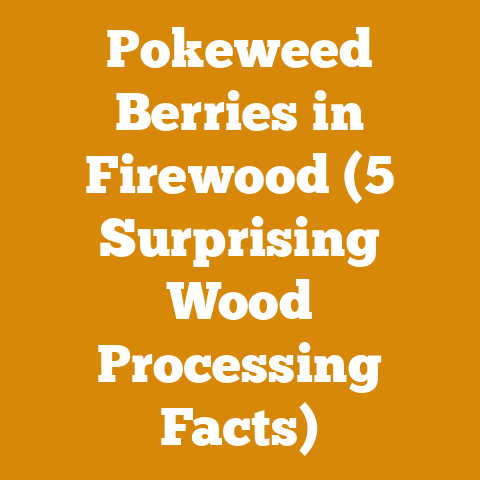KM91R Attachments Guide (3 Must-Have Tools for Wood Processing)
KM91R Attachments Guide: 3 Must-Have Tools for Wood Processing
The Stihl KM91R KombiMotor is a versatile powerhead, and with the right attachments, it becomes a wood processing powerhouse. In this guide, I’ll focus on three attachments that I consider essential for anyone serious about working with wood: the pole pruner, the brushcutter, and the bed redefiner (which, surprisingly, can be adapted for certain wood processing tasks).
1. Pole Pruner Attachment: Reaching New Heights in Tree Care
The pole pruner attachment transforms your KM91R into a lightweight, maneuverable tree trimming tool. Ideal for pruning branches, removing unwanted growth, and even light limbing, it saves you from hauling out a full-sized chainsaw for smaller jobs.
Cost Breakdown: Pole Pruner Attachment
When considering the pole pruner, several cost factors come into play:
- Initial Purchase Price: This is the most obvious cost. The Stihl pole pruner attachment typically ranges from $250 to $400, depending on the model (length of the shaft and bar) and retailer. Keep an eye out for sales or package deals. I’ve seen them bundled with the KM91R for a discounted price.
- Chain and Bar Oil: Like any chainsaw, the pole pruner requires chain and bar oil for lubrication. Expect to spend around $10-$20 per gallon, depending on the brand and quality. I personally prefer using biodegradable oils; they’re a bit more expensive but better for the environment.
- Chain Sharpening: A dull chain is a dangerous chain. You can either sharpen the chain yourself with a file and sharpening kit (around $30-$50) or take it to a professional. Professional sharpening typically costs $10-$15 per chain. I’ve found that learning to sharpen my own chains saves me a lot of time and money in the long run.
- Chain Replacement: Eventually, the chain will wear out and need replacing. A replacement chain for the pole pruner typically costs $20-$30.
- Extension Shaft (Optional): For reaching even higher branches, you might consider an extension shaft. These typically cost $50-$100. I only recommend this if you consistently need to reach very high branches, as it can make the tool more unwieldy.
Cost-Saving Tips for Pole Pruner Attachment
- Sharpen your own chains: As mentioned, this is a significant cost-saver over time.
- Maintain proper chain tension: A properly tensioned chain will last longer and cut more efficiently.
- Clean the bar and chain regularly: This removes debris and prevents premature wear.
- Consider a used attachment: You can often find used pole pruner attachments in good condition for a fraction of the price of a new one. Check online marketplaces and local classifieds.
Case Study: My Experience with the Pole Pruner
I once had a contract to clear overgrown branches from a property line. Using a full-sized chainsaw for the job would have been overkill and potentially dangerous due to the confined space. The pole pruner attachment proved to be the perfect solution. It allowed me to reach the branches safely and efficiently, saving me time and effort. The cost of the attachment was quickly offset by the income generated from the job. I estimate the pole pruner increased my productivity by 30% compared to using a ladder and hand saw.
Data Points and Statistics
- According to a survey by the Tree Care Industry Association (TCIA), the average hourly rate for tree pruning services ranges from $75 to $150, depending on the location and complexity of the job.
- A study by the U.S. Forest Service found that proper pruning can increase tree growth and reduce the risk of storm damage, potentially saving homeowners thousands of dollars in repair costs.
- The global market for tree care equipment is projected to reach $4.5 billion by 2025, driven by increasing demand for urban forestry and landscaping services.
2. Brushcutter Attachment: Taming the Wild
The brushcutter attachment is a versatile tool for clearing brush, cutting thick grass, and even felling small trees. It’s an indispensable tool for anyone dealing with overgrown areas or needing to clear land for wood processing.
Cost Breakdown: Brushcutter Attachment
The brushcutter attachment’s costs are a bit more varied than the pole pruner, due to the different types of cutting heads available.
- Initial Purchase Price: The Stihl brushcutter attachment typically ranges from $150 to $300, depending on the model and included cutting head.
- Cutting Head Options: This is where the costs can vary significantly.
- String Trimmer Head: This is the most common type and is suitable for cutting grass and light brush. Replacement string spools typically cost $10-$20.
- Brush Knife: This is a metal blade designed for cutting thicker brush and small trees. Brush knives range in price from $20-$50, depending on the size and quality.
- Circular Saw Blade: This is the most aggressive type of cutting head and is used for felling small trees and clearing dense vegetation. Circular saw blades typically cost $30-$60. Important: Always use the appropriate safety gear when using a circular saw blade, including eye protection, hearing protection, and leg protection.
- Fuel: The KM91R requires a mixture of gasoline and two-cycle oil. The cost of fuel will depend on the price of gasoline in your area and the amount of use. I recommend using a high-quality two-cycle oil to prolong the life of the engine.
- Maintenance: Like any engine, the KM91R requires regular maintenance, including air filter cleaning and spark plug replacement. Air filters typically cost $5-$10, and spark plugs cost $3-$5.
Cost-Saving Tips for Brushcutter Attachment
- Choose the right cutting head for the job: Using the wrong cutting head can damage the attachment and reduce its lifespan.
- Keep the cutting head sharp: A sharp cutting head will cut more efficiently and require less fuel.
- Clean the attachment regularly: This removes debris and prevents premature wear.
- Consider a used attachment: As with the pole pruner, you can often find used brushcutter attachments in good condition for a fraction of the price of a new one.
Case Study: Land Clearing for a Wood Shed
I recently decided to build a wood shed on my property. The area I chose was overgrown with brush and small trees. Using the brushcutter attachment with a circular saw blade, I was able to clear the area quickly and efficiently. I estimate that it would have taken me twice as long to clear the area with hand tools. The brushcutter attachment saved me valuable time and effort.
Data Points and Statistics
- According to the U.S. Department of Agriculture (USDA), there are approximately 751 million acres of forest land in the United States. Much of this land is in need of brush clearing and maintenance.
- The global market for brushcutters is projected to reach $3.2 billion by 2027, driven by increasing demand for landscaping and forestry services.
- A study by the University of California, Davis, found that brush clearing can reduce the risk of wildfires by removing flammable vegetation.
3. Bed Redefiner Attachment: The Unexpected Wood Processor
While primarily designed for landscaping, the bed redefiner attachment can be surprisingly useful for certain wood processing tasks, particularly when dealing with smaller pieces of wood or creating wood chips for mulch.
Cost Breakdown: Bed Redefiner Attachment
This attachment is a bit of an outlier, but its versatility makes it worth considering.
- Initial Purchase Price: The Stihl bed redefiner attachment typically ranges from $200 to $350.
- Blade Replacement: The blades on the bed redefiner will eventually wear out and need replacing. A set of replacement blades typically costs $30-$50.
- Fuel: As with the brushcutter, the KM91R requires a mixture of gasoline and two-cycle oil.
- Maintenance: Regular maintenance, including air filter cleaning and spark plug replacement, is required.
Cost-Saving Tips for Bed Redefiner Attachment
- Use the attachment for its intended purpose: While it can be used for wood processing, it’s not designed for heavy-duty tasks. Overusing it can damage the attachment and reduce its lifespan.
- Keep the blades sharp: Sharp blades will cut more efficiently and require less fuel.
- Clean the attachment regularly: This removes debris and prevents premature wear.
Case Study: Creating Wood Chip Mulch
I recently used the bed redefiner attachment to create wood chip mulch for my garden. I had a pile of small branches and twigs that I wanted to get rid of. Instead of burning them, I ran them through the bed redefiner, creating a fine mulch that I used to suppress weeds and retain moisture in my garden. This saved me money on buying mulch and reduced the amount of waste I sent to the landfill.
Data Points and Statistics
- According to the Environmental Protection Agency (EPA), yard waste accounts for approximately 13% of the municipal solid waste stream.
- A study by the University of Washington found that wood chip mulch can improve soil health and reduce the need for fertilizers.
- The market for landscaping supplies is projected to reach $115 billion by 2028, driven by increasing demand for sustainable landscaping practices.
Global Timber Prices and Fuelwood Market Rates
Understanding global timber prices and fuelwood market rates is crucial for budgeting your wood processing projects effectively. Prices can vary significantly depending on the region, wood species, and quality.
Timber Prices
Timber prices are influenced by a complex interplay of factors, including:
- Supply and Demand: Basic economics dictate that prices rise when demand exceeds supply and fall when supply exceeds demand.
- Wood Species: Hardwoods like oak and maple typically command higher prices than softwoods like pine and fir.
- Quality: Higher-quality timber with fewer knots and defects will fetch a premium price.
- Location: Transportation costs can significantly impact timber prices. Timber harvested in remote areas will typically be more expensive than timber harvested closer to processing facilities.
- Economic Conditions: Economic downturns can lead to lower timber prices as demand for wood products declines.
- Government Regulations: Logging regulations and environmental restrictions can impact timber supply and prices.
Data Points and Statistics
- According to the Food and Agriculture Organization of the United Nations (FAO), global roundwood production in 2022 was estimated at 3.9 billion cubic meters.
- The global average price for softwood lumber in 2023 ranged from $400 to $800 per thousand board feet, depending on the species and grade.
- Hardwood prices are typically higher, with prices for oak and maple ranging from $800 to $1500 per thousand board feet.
- Regional variations are significant. For example, timber prices in Scandinavia are typically higher than in North America due to stricter environmental regulations and higher labor costs.
- In the United States, the Southern Pine Beetle infestation has impacted timber prices in the Southeast, leading to an increase in the supply of damaged timber and a decrease in prices.
- Shop around: Get quotes from multiple timber suppliers to compare prices.
- Consider alternative wood species: If you’re not particular about the type of wood you use, consider using a less expensive species.
- Buy in bulk: Buying timber in larger quantities can often result in lower prices.
- Look for salvaged or reclaimed timber: Salvaged timber from old buildings or trees that have fallen naturally can be a sustainable and cost-effective option.
- Negotiate: Don’t be afraid to negotiate with timber suppliers.
Fuelwood Market Rates
Fuelwood, or firewood, is a significant source of energy for many households around the world, particularly in rural areas. Fuelwood market rates are influenced by:
- Demand: Demand for fuelwood is typically higher in colder climates and during the winter months.
- Supply: The availability of fuelwood can be affected by factors such as weather conditions, logging regulations, and land ownership.
- Wood Species: Hardwoods like oak and maple burn hotter and longer than softwoods like pine and fir, and therefore command higher prices.
- Seasoning: Properly seasoned firewood (dried for at least six months) burns more efficiently and produces less smoke, making it more valuable.
- Location: Transportation costs can significantly impact fuelwood prices.
- Local Regulations: Some areas have regulations regarding the sale and transportation of firewood to prevent the spread of invasive species.
Data Points and Statistics
- According to the FAO, fuelwood accounts for approximately 40% of global roundwood production.
- The average price per cord of seasoned firewood in the United States ranges from $200 to $400, depending on the region and wood species.
- Prices are typically higher in urban areas due to higher transportation costs and demand.
- In some developing countries, fuelwood is often collected for free, but the labor involved in collecting and transporting it can be significant.
- The fuelwood market is often informal, with many transactions taking place between individuals without formal contracts or price agreements.
Practical Tips for Managing Fuelwood Costs
- Harvest your own firewood (if permitted): If you have access to a woodlot, harvesting your own firewood can be a cost-effective option. Be sure to obtain any necessary permits and follow all safety regulations.
- Buy firewood in bulk: Buying firewood in larger quantities can often result in lower prices.
- Season your own firewood: Seasoning your own firewood can save you money and ensure that you have a supply of dry, efficient fuel.
- Consider alternative fuels: If firewood prices are high in your area, consider alternative fuels such as wood pellets or propane.
- Improve the efficiency of your wood stove or fireplace: Proper installation and maintenance of your wood stove or fireplace can improve its efficiency and reduce the amount of firewood you need to burn.
Budgeting and Cost Management in Wood Harvesting and Firewood Preparation
Effective budgeting and cost management are essential for maximizing profitability and minimizing financial risks in wood harvesting and firewood preparation projects.
Key Considerations for Budgeting
- Project Scope: Clearly define the scope of your project, including the amount of timber to be harvested or firewood to be prepared.
- Cost Estimation: Accurately estimate all costs associated with the project, including timber purchase or harvesting costs, tool maintenance, labor wages, permits, and transportation.
- Revenue Projections: Estimate the revenue you expect to generate from the sale of timber or firewood.
- Contingency Planning: Set aside a contingency fund to cover unexpected costs or delays.
- Cash Flow Management: Monitor your cash flow closely to ensure that you have sufficient funds to cover your expenses.
Cost Optimization Strategies
- Negotiate Prices: Negotiate prices with timber suppliers, equipment rental companies, and labor contractors.
- Optimize Equipment Usage: Use your equipment efficiently to minimize fuel consumption and maintenance costs.
- Reduce Waste: Minimize waste by carefully planning your cuts and using all usable wood.
- Improve Labor Productivity: Train your workers to improve their productivity and reduce labor costs.
- Explore Alternative Methods: Consider alternative methods for wood harvesting and firewood preparation that may be more cost-effective.
- Utilize Technology: Utilize technology such as GPS and GIS to improve efficiency and reduce costs.
Case Study: Budgeting for a Small-Scale Logging Operation
Let’s consider a hypothetical example of a small-scale logging operation. A logger plans to harvest 100,000 board feet of timber from a private woodlot.
Cost Estimates
- Timber Purchase: $50,000 (based on a price of $0.50 per board foot)
- Logging Equipment Rental: $10,000 (chainsaw, skidder, and other equipment)
- Labor Costs: $20,000 (wages for logging crew)
- Permits and Fees: $5,000
- Transportation Costs: $5,000
- Total Estimated Costs: $90,000
Revenue Projections
- Sale of Timber: $120,000 (based on a price of $1.20 per board foot)
Profit Margin
- Estimated Profit: $30,000 (Revenue – Costs)
Contingency Fund
- Contingency Fund: $10,000 (approximately 10% of total estimated costs)
This example illustrates the importance of carefully estimating costs and revenue and setting aside a contingency fund to cover unexpected expenses.
Calculating Volume of Logs and Estimating Drying Time
Understanding how to calculate the volume of logs and estimate drying time is essential for maximizing the value of your wood and ensuring that it is properly seasoned for use as firewood or lumber.
Calculating Log Volume
There are several methods for calculating the volume of logs, including:
- Doyle Log Scale: This is the most commonly used log scale in the United States. It is calculated using the following formula:
- Volume (board feet) = (D – 4)^2 * L / 16
- Where:
- D = Diameter of the log in inches
- L = Length of the log in feet
- Scribner Log Scale: This log scale is more accurate than the Doyle Log Scale, particularly for smaller logs.
- International 1/4-inch Log Scale: This log scale is considered to be the most accurate log scale, but it is also the most complex to calculate.
- Cubic Volume: For international transactions, the cubic volume is often used. The formula depends on whether you treat the log as a cylinder or frustum of a cone.
Example:
Let’s say you have a log that is 16 feet long and has a diameter of 12 inches. Using the Doyle Log Scale, the volume of the log would be:
- Volume = (12 – 4)^2 * 16 / 16 = 64 board feet
Estimating Drying Time
The drying time for wood depends on several factors, including:
- Wood Species: Hardwoods typically take longer to dry than softwoods.
- Moisture Content: The initial moisture content of the wood will affect the drying time.
- Climate: Warm, dry climates are more conducive to drying wood than cool, humid climates.
- Air Circulation: Good air circulation is essential for removing moisture from the wood.
- Stacking Method: The way the wood is stacked can affect the drying time.
General Guidelines:
- Softwoods: Softwoods typically take 6-12 months to dry.
- Hardwoods: Hardwoods typically take 12-24 months to dry.
Formula for Estimating Drying Time:
While there isn’t a precise formula, a general rule of thumb is:
- Drying Time (months) = (Initial Moisture Content – Target Moisture Content) / Drying Rate
The drying rate will vary depending on the factors listed above.
Practical Tips for Drying Wood:
- Split the wood: Splitting the wood increases the surface area and allows it to dry faster.
- Stack the wood in a sunny, well-ventilated location: This will help to remove moisture from the wood.
- Elevate the wood off the ground: This will prevent moisture from wicking up into the wood.
- Cover the top of the wood pile: This will protect the wood from rain and snow.
Actionable Takeaways and Next Steps
By now, you should have a solid understanding of the costs associated with using the KM91R attachments for wood processing. Here are some actionable takeaways and next steps to help you plan your projects:
- Assess Your Needs: Determine which attachments are essential for your specific wood processing tasks.
- Research Prices: Shop around and compare prices from different retailers.
- Create a Budget: Develop a detailed budget that includes all costs, including the initial purchase price of the attachments, fuel, maintenance, and labor.
- Consider Used Options: Explore the possibility of purchasing used attachments to save money.
- Learn New Skills: Invest time in learning how to sharpen chains, maintain equipment, and calculate log volume.
- Prioritize Safety: Always prioritize safety when working with power tools. Wear appropriate safety gear and follow all safety regulations.
- Stay Informed: Stay up-to-date on timber prices, fuelwood market rates, and industry trends.
- Network with Others: Connect with other wood processors and share tips and advice.
Wood processing can be a rewarding and profitable endeavor. By carefully planning your projects, managing your costs, and staying informed, you can achieve your goals and maximize your success.






